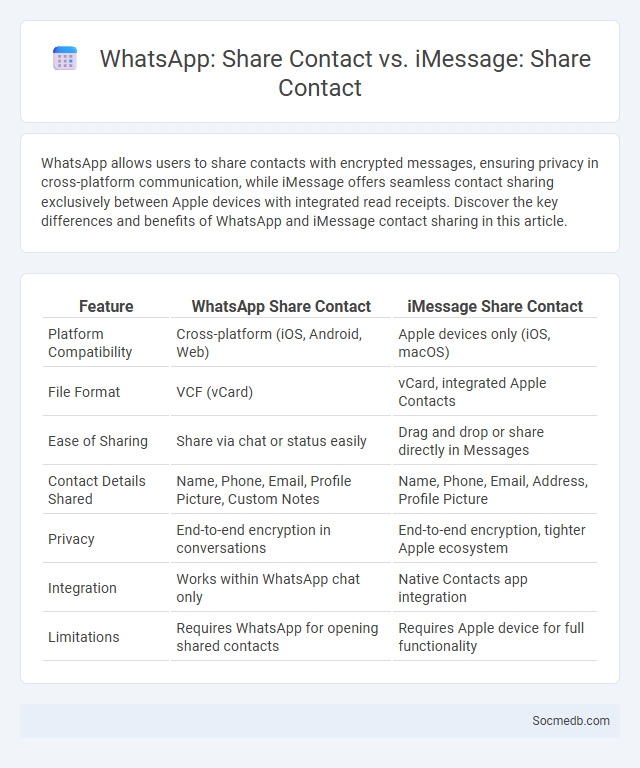
Photo illustration: WhatsApp share contact vs iMessage share contact
WhatsApp allows users to share contacts with encrypted messages, ensuring privacy in cross-platform communication, while iMessage offers seamless contact sharing exclusively between Apple devices with integrated read receipts. Discover the key differences and benefits of WhatsApp and iMessage contact sharing in this article.
Table of Comparison
| Feature | WhatsApp Share Contact | iMessage Share Contact |
|---|---|---|
| Platform Compatibility | Cross-platform (iOS, Android, Web) | Apple devices only (iOS, macOS) |
| File Format | VCF (vCard) | vCard, integrated Apple Contacts |
| Ease of Sharing | Share via chat or status easily | Drag and drop or share directly in Messages |
| Contact Details Shared | Name, Phone, Email, Profile Picture, Custom Notes | Name, Phone, Email, Address, Profile Picture |
| Privacy | End-to-end encryption in conversations | End-to-end encryption, tighter Apple ecosystem |
| Integration | Works within WhatsApp chat only | Native Contacts app integration |
| Limitations | Requires WhatsApp for opening shared contacts | Requires Apple device for full functionality |
Overview of Contact Sharing in Messaging Apps
Contact sharing in messaging apps enables seamless exchange of phone numbers, email addresses, and social profiles, enhancing communication efficiency. These apps use features like QR codes, direct sharing options, and integration with device contacts to simplify the process. Optimizing your messaging experience through effective contact sharing boosts connectivity and fosters stronger social media interactions.
WhatsApp Share Contact: How It Works
WhatsApp allows users to quickly share contact information through the "Share Contact" feature, which sends the selected person's details as a vCard within a chat. This vCard includes essential information such as phone numbers, email addresses, and profile pictures, enabling seamless addition to the recipient's contact list. The process enhances communication efficiency by eliminating manual entry and ensuring accurate data transfer between users.
iMessage Share Contact: Key Features
iMessage Share Contact allows you to quickly share contact information with friends, ensuring seamless communication and easy access to important details. This feature supports sending vCards within iMessage, preserving names, phone numbers, email addresses, and other vital data without manual entry. By using Share Contact, your conversations remain efficient and organized, reducing the chances of errors when exchanging contacts.
Contact Sharing Methods Across Platforms
Contact sharing methods across social media platforms vary widely, with features such as QR codes on Instagram and Snapchat, username searches on Twitter and LinkedIn, and direct sharing options via Facebook Messenger and WhatsApp. Platforms increasingly support automated contact syncing through phone contacts or email integration, enabling seamless connection building. Privacy settings and data encryption play crucial roles in managing who can access shared contact information across networks.
Privacy Considerations in Contact Sharing
When sharing contacts on social media, your privacy can be compromised if sensitive information is inadvertently exposed. Limiting access to your contact lists and reviewing app permissions regularly helps protect personal data from unauthorized use. Being mindful of privacy settings ensures that your connections remain secure while maintaining control over who can see your shared contacts.
User Experience: WhatsApp vs iMessage
WhatsApp and iMessage offer distinct user experiences tailored to different ecosystems, with WhatsApp excelling in cross-platform compatibility and extensive multimedia sharing options. Your choice depends on device preference; iMessage provides seamless integration for Apple users, featuring end-to-end encryption and intuitive group chat functionalities. Both platforms prioritize user engagement but differ in customization and global reach, influencing how you connect with contacts worldwide.
Security Features: Protecting Shared Contacts
Social media platforms implement advanced security features such as end-to-end encryption, two-factor authentication, and access control settings to protect shared contacts from unauthorized access. Contact sharing permissions can be customized to limit visibility to trusted networks, reducing the risk of data breaches. Continuous monitoring and AI-driven threat detection systems play a crucial role in safeguarding users' social connections across popular platforms like Facebook, LinkedIn, and WhatsApp.
Limitations and Compatibility Issues
Social media platforms often face limitations related to data privacy, content moderation, and algorithm biases that can impact user experience and trust. Compatibility issues arise from varying device capabilities, operating systems, and app versions, which may lead to inconsistent functionality and accessibility challenges. To ensure seamless interaction and secure usage, Your choice of social media should consider platform compatibility with your devices and adherence to robust privacy policies.
Best Practices for Sharing Contacts Safely
To share contacts safely on social media, utilize secure messaging platforms that offer end-to-end encryption, ensuring that personal information remains private and protected from unauthorized access. Limit the amount of contact information shared publicly by using privacy settings to restrict visibility to trusted connections only. Regularly update and review shared contact lists to remove outdated or unnecessary details, minimizing potential exposure to phishing or identity theft risks.
Future Trends in Digital Contact Sharing
Future trends in digital contact sharing emphasize the integration of augmented reality (AR) and blockchain technology to enhance privacy and user engagement. Artificial intelligence-driven contact management systems will enable seamless updates and personalized networking experiences across platforms. The rise of decentralized social networks will shift control of contact information back to users, fostering trust and security in social media interactions.
 socmedb.com
socmedb.com